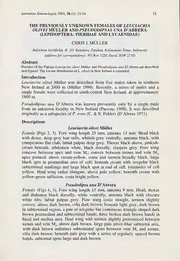
The previously unknown females of Leuciacria olivei Muller and Pseudodipsas una DAbrera (Lepidoptera: Pieridae and Lycaenidae) PDF
Preview The previously unknown females of Leuciacria olivei Muller and Pseudodipsas una DAbrera (Lepidoptera: Pieridae and Lycaenidae)
Australian Entomologist, 2001, 28 (1): 23-24 23 THE PREVIOUSLY UNKNOWN FEMALES OF LEUCIACRIA OLIVEI MULLER AND PSEUDODIPSAS UNA D9ABRERA (LEPIDOPTERA: PIERIDAE AND LYCAENIDAE) CHRIS J. MULLER Indochina Goldfields, Jl. 141 Sumatera, Tarakan, Kalimantan Timur, Indonesia (address for correspondence: PO Box 3228, Dural, NSW 2158) Abstract Females of the Papuan Leuciacria olivei Miiller and Pseudodipsas una D9 Abrera are described and figured. The known distribution of L. olivei in New Ireland is extended. Introduction Leuciacria olivei Miiller was described from five males taken in southern New Ireland at 2400 m (Miiller 1999). Recently, a series of males and a single female were collected in south-central New Ireland, at approximately 1800 m. Pseudodipsas una D9 Abrera was known previously only by a single male from an unknown locality in New Ireland (Parsons 1998). It was described originally as a subspecies of P. eone (C. & R. Felder) (D9 Abrera 1971). Descriptions Leuciacria olivei Miller Female (Figs 2, 3). Fore wing length 25 mm, antenna 13 mm. Head black with dense, deep grey hair tufts, whitish-grey ventrally; antenna black, with conspicuous flat club; labial palpus deep grey. Thorax black above, pinkish- cream beneath. Abdomen white, black dorsally, claspers grey. Fore wing concave between apex and vein M,, convex between tornus and vein M,, apex pointed; above cream-yellow, costa and termen broadly black, large black spot in postmedian area of cell; beneath cream with irregular black subterminal markings and large black spot at end of cell, remainder of cell yellow. Hind wing rather elongate, above pale yellow; beneath cream with yellow-green suffusion, costa bright yellow. Pseudodipsa una D9 Abrera Female (Figs 4, 5). Fore wing length 13 mm, antenna 9 mm. Head, thorax and abdomen black dorsally, white ventrally; antenna black with obscure white ribs; labial palpus grey. Fore wing costa straight, termen slightly convex; above dark brown, cilia dark brown; beneath light grey, dark brown in subterminal region, a pair of irregular but continuous triangle-shaped dark brown postmedian and subterminal bands, three broken dark brown bands in basal and median area. Hind wing with termen slightly pronounced between tornus and vein M,, above dark brown, large pale silver-blue subtornal area, with dark brown indistinct subterminal spots between vein M, and tornus, cilia dark brown; beneath pale grey with a series of regularly spaced brown bands, subtornal spots large and dark brown. 24 Australian Entomologist, 2001, 28 (1) Figs 1-5. (1) Leuciacria olivei male, upperside. (2) L. olivei female, upperside. (3) L. olivei female, underside. (4) Pseudodipsas una female, upperside. (5) P. una female, underside. Scale bar = 1 cm. Discussion Leuciacria olivei is sexually dimorphic. The described female differs markedly from those of L. acuta Rothschild & Jordan in the more elongate hind wing, absence of markings on the hind wing, large fore wing cell spot and overall yellow suffusion of both wing surfaces. The holotype male of L. olivei has more black on the fore wing apex than other known specimens; the majority possess little or no black on the fore wing (Fig. 1). In addition to the types and other specimens taken in the Hans Meyer Range, southern New Ireland, several males were observed flying about 20 m above the ground in the Schleinitz Mountains, central New Ireland, at 1400 m, extending the known range approximately 200 km north-east. Females of P. una closely resemble males but have broader, more rounded wings. Both sexes may be distinguished from other Pseudodipsas C. & R. Felder species by the absence of orange markings around the tornal spots on the hind wing underside. Females also have an extensive pale blue subtornal area on the hind wing upperside. The described female was collected in a forested gully in the Schleinitz Mountains at 1000 m, where it was flying with several other lycaenids, including Erysichton albiplaga Tite. At least two males of P. una were observed to fly rapidly and settle briefly on a ridge summit at 1100 m. References D9ABRERA, B. 1971. Butterflies of the Australian Region. Lansdowne Press, Melbourne, Australia; 415 pp. MULLER, C.J. 1999. A new species of Leuciacria Rothschild & Jordan (Lepidoptera: Pieridae) from montane New Ireland, Papua New Guinea. Australian Entomologist 26(3): 65-70. PARSONS, M.J. 1998. The butterflies of Papua New Guinea; their systematics and biology. Academic Press, London; 736 pp.
